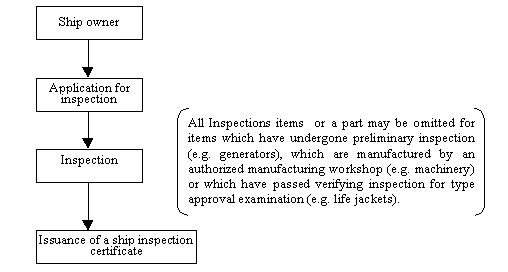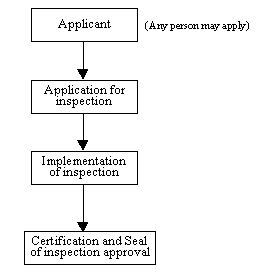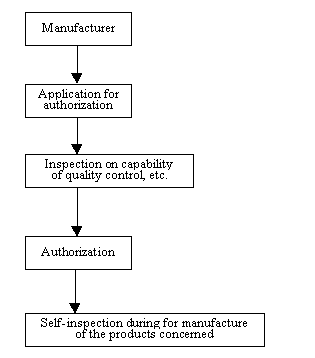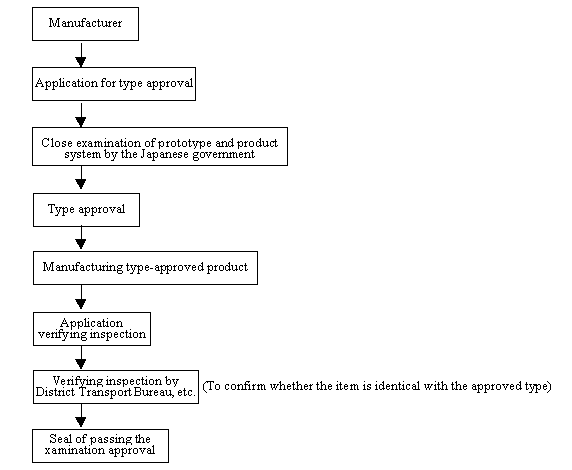The purposes of this Law are to ensure the seaworthiness of vessels and to protect lives.
(2) OUTLINE OF THE LAW AND SYSTEM
By being prescribed requirements for structure and equipment necessary to ensure the safety of vessels, in order to confirm whether or not a vessel satisfies these requirements, vessel inspections are carried out (Articles 5 and 6). In order to alleviate the burden to owners of vessels, the rationalization of vessel inspections are carried out by introducing a type approval system, etc. for mass-produced vessels or items for vessels (Articles 6-2, 6-3 and 6-4).
(3) CABINET ORDER AND MINISTERIAL ORDINANCES
Enforcement Order of the Ship Safety Law
Enforcement Regulations of the Ship Safety Law
Rules for Ship Equipment
Regulations of the Type Approval of Ships, etc.
Safety Regulations for Small Ships
(4) OUTLINE OF SPECIFICATIONS. STANDARDS AND INSPECTIONS, ETC.
1) Items Covered
Vessels with Japanese registry (The Law is also applied mutatis mutandis to foreign vessels operating exclusively in the enforcement area of the Law)
2) Outline of the Control
(a) Standards
Technical Standards regarding hull, machinery, life-saving appliances, equipment for fire-fighting and other ship-related equipment are prescribed in accordance with related international conventions. Taking the international nature of vessels and shipping into consideration, standards for vessels are set in accordance with international conventions (e. g. the International Convention for the Safety of Life at Sea) and are drafted into domestic law following the revision of said conventions by the International Maritime Organization (IMO).
(b) Inspections
<Newly constructed>
Design inspection of newly constructed vessels, inspection during construction (materials, welding, pressure proofing, etc.), inspections after construction (the sea trial, etc.) are carried out. Because imported ships are imported as a finished product, it is very difficult to carry out inspections during the manufacturing process. Despite of such difficulties, Japan tries to facilitate such inspections using inspection results produced by foreign testing authorities.
<Inspections after vessels are put into service>
Inspections of the actual state and strength and validity confirmation inspections are carried out periodically. Owners of vessels apply for inspections such as periodical inspections, intermediate inspections, occasional inspections and manufacturers of ships apply for manufacturing inspections. District Transport Bureaus or Maritime Branch Offices such as the Competent Maritime Authorities inspect vessels of more than 20 tons gross tonnage. The Japan Craft Inspection Organization inspects vessels of less than 20 tons gross tonnage (except for specific vessels such as special boats).
In order to streamline ship inspection procedures, it maybe exempted from inspections for items installed on boats in cases where these items have already cleared preliminary inspections. It may also be exempted from manufacturing process inspections for construction work and maintenance work carried out at certified manufacturing sites. Furthermore, a periodical inspection is an examination of an operational vessel taken for the first time or on the expiry date of a ship inspection certificate. Whereas, an interim inspection is an examination taken between periodical inspections (three years).
3) Procedure for Application
Applicants file, a written application for ship inspection together with necessary documents with the District Transport Bureau or the District Maritime Branch Offices.
4) Certification System
Manufacturing process inspections may be omitted for items manufactured in workshops which conform to the specified quality control standards. First inspections to be carried out in detail on ship equipment installed on board the vessel are exempted in cases where equipment has already passed type approval and examination. Regarding type approval for foreign manufacturers' products, Japan facilitates usage of inspection data produced by foreign testing authorities.
No ship which does not conform to the specified technical standards for structure, equipment, etc. shall be operated (Article 1). Ship inspections are carried out in order to confirm whether or not ships conform to the specified standards (Article 5). Ships which pass the inspection are issued ship inspection certificates (Article 9).
The following certification systems are provided in order to simplify ship inspection procedures:
(a) Preliminary inspection system (Article 6).
Specific articles may be admitted for inspection before the ship to be equipped with such items is specified.
(b) Type approval system (Article 6-4)
After the type is approved Japanese Government etc., conduct a verifying inspection to ensure and certify that the products in question are manufactured to the same standards as the prototype of model
(c) Authorization system of manufacturing (Article 6-2)
[Flowchart of Certification System]
(A) Ship Inspection (Inspection of newly-constructed ships)

(B) Preliminary Inspection (Products covered: internal combustion engines, pumps, boilers, generators, transformers, etc.)

(C) Authorization system of manufacturing (Products covered: steel hulls, generators, steam turbines, internal combustion engines, etc.)

(D) Type Approval (Products covered: navigation radar equipment, life jacket, ship lights, etc.)

(5) HIGHLIGHTS OF THE RECENT AMENDMENT
1)Flexibility of an inspection period (for example, an interimediate inspection period for small-sized vessels other than passenger ships becomes more flexibly from one month to three month before and after the relevant year.
2)New establishment of technical standard of coastal small ships (Improvement of utility by installing technical standard of small ships that sail in the same water area that can be sailable with a license for the second class small ship pilot: in 2004)
(6) REFERENCE INFORMATION
(Liaison Office for Further Information)
Safety Standards Division and Inspection and Measurement Division, Maritime Bureau, Ministry of Land, Infrastructure and Transport
Tel: 03-5253-8111 http://www.mlit.go.jp